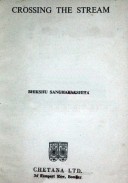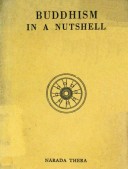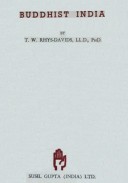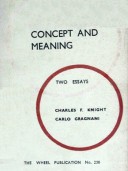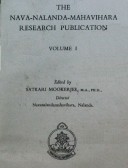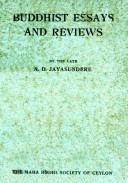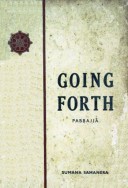Tìm Sách
Sách tiếng Anh-English >> The Nava Nalanda Mahavihara Research Publication Vol. II
Thông tin tra cứu
- Tên sách : The Nava Nalanda Mahavihara Research Publication Vol. II
- Tác giả : Satkri Mookerjee
- Dịch giả :
- Ngôn ngữ : Anh
- Số trang : 110
- Nhà xuất bản : Varanasi India
- Năm xuất bản : 1960
- Phân loại : Sách tiếng Anh-English
- MCB : 1210000003432
- OPAC :
- Tóm tắt :
PREFACE
We have great pleasure in introducing to the academic world the Volume II of The Nava Nãlandã Mahãvihãra Retearch Publication. Just like its predecessor, it is also the outcome of team-work in which several scholars have taken part. The majority of the articles relate to Buddhist thought. It is a happy feature that all the contributors have been associated with our Institute, in one capacity or another. The old Nãlandã Mahãvihãra was noted for its universalistic outlook and wide intellectual interests. There was no branch of knowledge in India which was not cultivated within its precincts. Our Institute (Nava Nãlandã Mahãvihãra) is, not only by its nomenclature but also in its aims, objectives and aspirations an humble successor; and the hopes of the Buddhist World will be fulfilled only when this infant institute will grow in dimensions and reach the zenith of its development to justify the name and anscestory which it claims. Accordingly, we have not been squeamish and did not impose restrictions on our contributors. The papers, each in their own way, throw light on subjects which were studied in ancient India. The speciality of this Volume is that it contains articles both in English and Hindi.
We now propose to give a running survey of the subject matter of the contents. The first article is entitled ‘The Omniscient as the Founder of Religion.’ It treats of a subject, which has not only a religious appeal but a metaphysical interest. It was suggested by the late Sir Brajendra Nath Seal, the then George V Professor of Philosophy in Calcutta University in about 1930, that this subject should be studied and presented to the modern world, with its metaphysical foundation. The writer also felt that the problem did not outlive its interest and utility. The second article is entitled ‘The Nature of Ultimate Reality’, and it has been tackled from the standpoint of diverse Schools of Indian philosophy.
The third paper deals with the Sarvãstivãda, the philosophical position perhaps, of the oldest Buddhist School, which dominated the intellectual and religious atmosphere of India and Central Asia for several centuries. The original literature of the School in Sanskrit is entirely lost and survives only in Chinese and Tibetan translations. The writer has drawn upon Vasubandhu’s Abhidharmakosu and the Sphutãrthã. The fourth paper deals with the problem of Avyãkrtas, the vexed questions which were not answered by the Buddha. The author throws a new light and the problem receives a new orientation.
The fifth article gives the original Pali text of the Vuttodaya and its English exposition. The subject has an interest for the students of Pali in which the verses intermingle with prose.
The sixth occupies itself with the ‘Methodology of Vibhangappakarana’. It presents a comprehensive study of the method followed in Abhidhamma Literature, which with its diverse enumerations, permutations and combinations of the different psychical factors charged with an ethical tone is apt to confuse a neophyte. In the light of the present exposition the Abhidhamma texts will be sized up and the student will be conducted into the central core of the topics.
The seventh article deals with ‘Anandavardhana’s Concept of Dosa’—a subject which has a perennial interest for students of literature. Anandavardhana was an epoch-making writer of the 9th century A. D. and has influenced the standard of literary criticism in India for several centuries and his influence has not been undermined by powerful critics.
‘Nature in the Theragẫthã’ is the subject-matter of the eighth article. It seeks to show that the Buddhist Elders, though their interests were overwhelmingly religious and spiritual, were not impervious to the aesthetic aspects of Nature.
The ninth article ‘Abhidharmãvatãra by an Unidentified Author’ is a reconstruction from Tibetan and Chinese texts. It has-been contributed by Prof. Hajime Sakurabe, the quondam Professor of Chinese and Japanese in our Institute. The importance of the contribution cannot be overrated, our knowledge of Abbidharma Literature in Sanskrit is compelled by circumstances to be sectional owing to the loss of original literature. This lacuna can be filled up only by reconstruction, study and exposition of the Chinese and Tibetan sources in which the translations of the original works are preserved. Prof. H. Sakurabe has specialised in Abhidbarma and his contribution bears the stamp of authority.
The next contribution deals with some aspects of social life in the Sixth Century B. C. The last article in English is contributed by Shri S. V. Soboni, I. C. S., President of the Nava Nãlanda Mahãvihãra, who is a recognised authority in Ancient Indian History & Culture and the guardian angel of our Institute.
Now we come to the articles in Hindi. The first treats of Nirvana in the Lankãvatãra Sũtra. The second gives a survey of the materialistic Philosophy of the Cãrvãka School, which is noticed in the Vedas and Upanisads and also in Buddhist Literature. The third is a study of Sarahapã, one of the leading figures in Siddha Literature, which is preserved in Tibetan. The last one is a Hindi translation of some works of Dĩpankara Srijnãna from Tibetan. Dipankara was one of the latest patriarchs of Vikramasilã monastery. He migrated in his old age to Tibet to preach the holy religion of the Buddha and died in harness in the snow-clad country. The writer is a Tibetan by birth and Buddhist by faith. He writes good Hindi and his translation naturally inherits the importance of the original works which are lost in Sanskrit.
With these prefatory observations I present this work to the academic world. I hope that it will be received by scholars with the generous feelings which were bestowed on our first volume.
I shall be failing in my duty if I do not thankfully acknowledge the hearty cooperation of the members of the staff of the Institute and the Printers, The Tara Printing Works, Varanasi.
S. Mookerjee, M. A. Ph. D.
Director,
Nalanda, 30th March, 1960.
Nava Nalanda Mahavihara.
CONTENTS
- The Omniscient as the Founder of a Religion – Prof. S. Mookerjee
- The Nature of Ultimate Reality – Prof. S. Mookerjee
- Sarvãstivãda – Prof. Nathmal Tatia
- The Atyikrtas or Indeterminables – Prof. Nathmal Tatia
- The Vuttodaya (The Pali Prosody) – Dr. B. Jinaoanda
- The Methodology of Vibhangappakarana – Dr. U. Dhammaratana
- Anandvardhana’s Concept of Dosa – Prof. B. Jha
- Nature in the Theragãthã – Prof. Ang Raj Cbaudhary
- Abhidhannãvatãra by an Unidentified Author – Prof. Hajime Sakurabe
- Some Aspects of Social Life of Ancient India in the 6th Century B. C. as Depicted in the Brahmajãla Sutta – Prof. D. K. Banerji
- A Medallion at Deogarh – Shri S. V. Sohoni I.C.S., M.A.
- Index
 Facebook
Facebook
 Google
Google
 Google+
Google+


